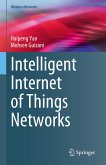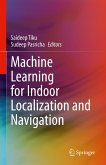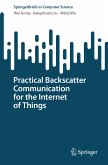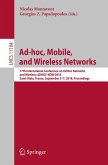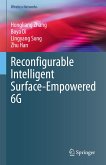Zhiguo Shi, Chaojie Gu, Shibo He, Kang Hu
LoRa Localization (eBook, PDF)
System Design and Performance Analysis
36,95 €
36,95 €
inkl. MwSt.
Sofort per Download lieferbar

18 °P sammeln
36,95 €
Als Download kaufen

36,95 €
inkl. MwSt.
Sofort per Download lieferbar

18 °P sammeln
Jetzt verschenken
Alle Infos zum eBook verschenken
36,95 €
inkl. MwSt.
Sofort per Download lieferbar
Alle Infos zum eBook verschenken

18 °P sammeln
Zhiguo Shi, Chaojie Gu, Shibo He, Kang Hu
LoRa Localization (eBook, PDF)
System Design and Performance Analysis
- Format: PDF
- Merkliste
- Auf die Merkliste
- Bewerten Bewerten
- Teilen
- Produkt teilen
- Produkterinnerung
- Produkterinnerung

Bitte loggen Sie sich zunächst in Ihr Kundenkonto ein oder registrieren Sie sich bei
bücher.de, um das eBook-Abo tolino select nutzen zu können.
Hier können Sie sich einloggen
Hier können Sie sich einloggen
Sie sind bereits eingeloggt. Klicken Sie auf 2. tolino select Abo, um fortzufahren.

Bitte loggen Sie sich zunächst in Ihr Kundenkonto ein oder registrieren Sie sich bei bücher.de, um das eBook-Abo tolino select nutzen zu können.
- Geräte: PC
- ohne Kopierschutz
- eBook Hilfe
- Größe: 4.74MB
Andere Kunden interessierten sich auch für
![Intelligent Internet of Things Networks (eBook, PDF) Intelligent Internet of Things Networks (eBook, PDF)]() Haipeng YaoIntelligent Internet of Things Networks (eBook, PDF)137,95 €
Haipeng YaoIntelligent Internet of Things Networks (eBook, PDF)137,95 €![Machine Learning for Indoor Localization and Navigation (eBook, PDF) Machine Learning for Indoor Localization and Navigation (eBook, PDF)]() Machine Learning for Indoor Localization and Navigation (eBook, PDF)81,95 €
Machine Learning for Indoor Localization and Navigation (eBook, PDF)81,95 €![Practical Backscatter Communication for the Internet of Things (eBook, PDF) Practical Backscatter Communication for the Internet of Things (eBook, PDF)]() Wei GongPractical Backscatter Communication for the Internet of Things (eBook, PDF)36,95 €
Wei GongPractical Backscatter Communication for the Internet of Things (eBook, PDF)36,95 €![Ad-hoc, Mobile, and Wireless Networks (eBook, PDF) Ad-hoc, Mobile, and Wireless Networks (eBook, PDF)]() Ad-hoc, Mobile, and Wireless Networks (eBook, PDF)40,95 €
Ad-hoc, Mobile, and Wireless Networks (eBook, PDF)40,95 €![Reconfigurable Intelligent Surface-Empowered 6G (eBook, PDF) Reconfigurable Intelligent Surface-Empowered 6G (eBook, PDF)]() Hongliang ZhangReconfigurable Intelligent Surface-Empowered 6G (eBook, PDF)129,95 €
Hongliang ZhangReconfigurable Intelligent Surface-Empowered 6G (eBook, PDF)129,95 €![Proceedings of Innovative Computing 2024, Vol. 2 (eBook, PDF) Proceedings of Innovative Computing 2024, Vol. 2 (eBook, PDF)]() Proceedings of Innovative Computing 2024, Vol. 2 (eBook, PDF)113,95 €
Proceedings of Innovative Computing 2024, Vol. 2 (eBook, PDF)113,95 €![Proceedings of Innovative Computing 2024, Vol. 4 (eBook, PDF) Proceedings of Innovative Computing 2024, Vol. 4 (eBook, PDF)]() Proceedings of Innovative Computing 2024, Vol. 4 (eBook, PDF)113,95 €
Proceedings of Innovative Computing 2024, Vol. 4 (eBook, PDF)113,95 €-
-
-
Produktdetails
- Verlag: Springer International Publishing
- Seitenzahl: 97
- Erscheinungstermin: 8. Juli 2024
- Englisch
- ISBN-13: 9783031480089
- Artikelnr.: 71233367
Dieser Download kann aus rechtlichen Gründen nur mit Rechnungsadresse in A, B, BG, CY, CZ, D, DK, EW, E, FIN, F, GR, HR, H, IRL, I, LT, L, LR, M, NL, PL, P, R, S, SLO, SK ausgeliefert werden.
- Herstellerkennzeichnung Die Herstellerinformationen sind derzeit nicht verfügbar.
Zhiguo Shi received the B.S. and Ph.D. degrees in electronic engineering from Zhejiang University, Hangzhou, China, in 2001 and 2006, respectively. Since 2006, he has been a faculty member with the College of Information Science and Electronic Engineering, Zhejiang University, where he is currently a full professor. From 2011 to 2013, he was visiting the Broadband Communications Research Group, University of Waterloo, Waterloo, ON, Canada. His current research interests include array signal processing, target tracking and positioning, IoT system design, and anti-drone system technic and system. He has more than 100 issued patents. He is serving/served as an AE of IEEE Signal Processing Letters, IEEE Transactions on Vehicular Technology, IEEE Network, IET Communications, and Journal of The Franklin Institute. He served as the general co-chair of IEEE SAM 2020, and will serve as the TPC co-chair of IEEE/CIC ICCC 2024
Chaojie Gu received the B.Eng.degree from Harbin Institute of Technology, China, in 2016, and the Ph.D. degree in computer science and engineering from Nanyang Technological University, Singapore, in 2020. He was a Research Fellow with Singtel Cognitive and Artificial Intelligence Lab for Enterprise (SCALE) in 2021. He is an Assistant Professor with the College of Control Science and Engineering, Zhejiang University, Hangzhou, China. His research interests include IoT, industrial IoT, edge computing, and low power wide area network.
Shibo He received the Ph.D. degree in control science and engineering from Zhejiang University, Hangzhou, China, in 2012. He is currently a Professor with Zhejiang University. He was an Associate Research Scientist in 2014 for two months and a Post-Doctoral Scholar from 2012 to 2014 with Arizona State University, Tempe, AZ, USA. From 2010 to 2011, he was a Visiting Scholar with the University of Waterloo, Waterloo, ON, Canada. His current researchinterests include wireless sensor networks, crowdsensing, and big data analysis. Dr. He serves on the Editorial Board of the IEEE Transactions on Vehicular Technology, Springer's Peer-to-Peer Networking and Application and KSII Transactions on Internet and Information Systems. He has been a Guest Editor of Elsevier's Computer Communications and Hinda WI's International Journal of Distributed Sensor Networks.
Kang Hu received the B.Sc. degree from the School of Mechanical Engineering and Electronic Information, China University of Geosciences, Wuhan, China, in 2017, and the Ph.D. degree from Zhejiang University, Hangzhou, China, in 2022. He is currently working for the IoT department of Alibaba. His research interests include low-power wide-area networks and localization.
Chaojie Gu received the B.Eng.degree from Harbin Institute of Technology, China, in 2016, and the Ph.D. degree in computer science and engineering from Nanyang Technological University, Singapore, in 2020. He was a Research Fellow with Singtel Cognitive and Artificial Intelligence Lab for Enterprise (SCALE) in 2021. He is an Assistant Professor with the College of Control Science and Engineering, Zhejiang University, Hangzhou, China. His research interests include IoT, industrial IoT, edge computing, and low power wide area network.
Shibo He received the Ph.D. degree in control science and engineering from Zhejiang University, Hangzhou, China, in 2012. He is currently a Professor with Zhejiang University. He was an Associate Research Scientist in 2014 for two months and a Post-Doctoral Scholar from 2012 to 2014 with Arizona State University, Tempe, AZ, USA. From 2010 to 2011, he was a Visiting Scholar with the University of Waterloo, Waterloo, ON, Canada. His current researchinterests include wireless sensor networks, crowdsensing, and big data analysis. Dr. He serves on the Editorial Board of the IEEE Transactions on Vehicular Technology, Springer's Peer-to-Peer Networking and Application and KSII Transactions on Internet and Information Systems. He has been a Guest Editor of Elsevier's Computer Communications and Hinda WI's International Journal of Distributed Sensor Networks.
Kang Hu received the B.Sc. degree from the School of Mechanical Engineering and Electronic Information, China University of Geosciences, Wuhan, China, in 2017, and the Ph.D. degree from Zhejiang University, Hangzhou, China, in 2022. He is currently working for the IoT department of Alibaba. His research interests include low-power wide-area networks and localization.
1 Introduction.- 1.1 Background .- 1.1.1 Internet of Things (IoT).- 1.1.2 Low Power Wide Area Network (LPWAN).- 1.1.3 Location-based Internet of Things Services and Industrial Applications.- 1.2 Current Situation and Challenge.- 1.2.1 Challenges and Contributions.- 1.3 Book Organization.- References .- 2 Wireless Localization Model and Hardware Foundation.- 2.1 LoRa and its Ranging Engine.- 2.1.1 LoRa Network Structure.- 2.1.2 LoRa Nodes Distance Estimation.- 2.1.3 LoRa Nodes Angle Estimation.- 2.2 Angle of Arrival (AoA) Estimation.- 2.3 Hardware.- 2.3.1 Hardware Platform Design.- 2.3.2 Heterogeneous Devices and Protocol Interface Design.- References.- 3 LoRa-based Mobile Localization System.- 3.1 System Model.- 3.1.1 System Overview.- 3.1.2 Localization Model.- 3.2 Distance and Location Estimation.- 3.2.1 Distance Estimation.- 3.2.2 Anchor Location Estimation.- 3.3 Localization Optimization.- 3.4 Implementation and Evaluation.- 3.4.1 System Implementation.- 3.4.2 Localization Simulations.- 3.4.3 System Evaluation.- 3.5 Summary.- References.- 4 Wide-Area Localization System Based on LoRa Mesh.- 4.1 Hardware Design.- 4.2 LoRa Mesh Protocol Design.- 4.2.1 The Structure of the Mesh Protocol.- 4.2.2 Route Discovery and Maintenance.- 4.2.3 Routing Algorithm .- 4.3 LoRa Ranging and Localization .- 4.3.1 Localization Workflow.- 4.3.2 Ranging Algorithm.- 4.3.3 Localization Algorithm.- 4.4 Implementation.- 4.4.1 Control and Visualization Interface.- 4.4.2 Anchors Deployment .- 4.5 Evaluation.- 4.5.1 Ranging Experiment .- 4.5.2 Positioning Experiment.- 4.6 Summary.- References.- 5 Enable Angle of Arrival in LoRa for Efficient Indoor Localization.- 5.1 Problem formulation and Challenges.- 5.2 Redesign of LoRa Gateway and Ranging Procedure.- 5.2.1 Gateway Redesign.- 5.2.2 Leveraging Ranging Difference.- 5.2.3 Ranging Procedure Redesign.- 5.3 Improving AoA Estimation via Rotation.- 5.3.1 Binary AoA Classification.- 5.3.2 Virtual Array.- 5.3.3 AoA Calculation.- 5.4 Implementation and Applications.- 5.4.1 Implementation.- 5.4.2 Applications.- 5.5 Performance Evaluation.- 5.5.1 Ranging Difference Estimation .- 5.5.2 AoA Estimation.- 5.5.3 NLoS Localization .- 5.5.4 Power Consumption Evaluation .- 5.6 Summary.- References .- 6 LoRa-based Indoor Tracking System for Mobile Robots.- 6.1 Estimating the AoA.- 6.1.1 AoA Estimation with an Antenna Array.- 6.1.2 Minimize Ranging Interval .- 6.2 Eliminating the Blind Area.- . 6.3 Estimating Target Movement .- 6.3.1 Target Motion Model.- 6.3.2 Real-Time Frequency Estimation.- 6.4 System Implementation.- 6.5 Performance Evaluation.- 6.5.1 Indoor Experiments.- 6.5.2 Deploy Ability Investigation.- 6.6 Summary.- References.- 7 Conclusion and Future Directions.- 7.1 Concluding Remarks .- 7.2 Future Directions.
1 Introduction.- 1.1 Background .- 1.1.1 Internet of Things (IoT).- 1.1.2 Low Power Wide Area Network (LPWAN).- 1.1.3 Location-based Internet of Things Services and Industrial Applications.- 1.2 Current Situation and Challenge.- 1.2.1 Challenges and Contributions.- 1.3 Book Organization.- References .- 2 Wireless Localization Model and Hardware Foundation.- 2.1 LoRa and its Ranging Engine.- 2.1.1 LoRa Network Structure.- 2.1.2 LoRa Nodes Distance Estimation.- 2.1.3 LoRa Nodes Angle Estimation.- 2.2 Angle of Arrival (AoA) Estimation.- 2.3 Hardware.- 2.3.1 Hardware Platform Design.- 2.3.2 Heterogeneous Devices and Protocol Interface Design.- References.- 3 LoRa-based Mobile Localization System.- 3.1 System Model.- 3.1.1 System Overview.- 3.1.2 Localization Model.- 3.2 Distance and Location Estimation.- 3.2.1 Distance Estimation.- 3.2.2 Anchor Location Estimation.- 3.3 Localization Optimization.- 3.4 Implementation and Evaluation.- 3.4.1 System Implementation.- 3.4.2 Localization Simulations.- 3.4.3 System Evaluation.- 3.5 Summary.- References.- 4 Wide-Area Localization System Based on LoRa Mesh.- 4.1 Hardware Design.- 4.2 LoRa Mesh Protocol Design.- 4.2.1 The Structure of the Mesh Protocol.- 4.2.2 Route Discovery and Maintenance.- 4.2.3 Routing Algorithm .- 4.3 LoRa Ranging and Localization .- 4.3.1 Localization Workflow.- 4.3.2 Ranging Algorithm.- 4.3.3 Localization Algorithm.- 4.4 Implementation.- 4.4.1 Control and Visualization Interface.- 4.4.2 Anchors Deployment .- 4.5 Evaluation.- 4.5.1 Ranging Experiment .- 4.5.2 Positioning Experiment.- 4.6 Summary.- References.- 5 Enable Angle of Arrival in LoRa for Efficient Indoor Localization.- 5.1 Problem formulation and Challenges.- 5.2 Redesign of LoRa Gateway and Ranging Procedure.- 5.2.1 Gateway Redesign.- 5.2.2 Leveraging Ranging Difference.- 5.2.3 Ranging Procedure Redesign.- 5.3 Improving AoA Estimation via Rotation.- 5.3.1 Binary AoA Classification.- 5.3.2 Virtual Array.- 5.3.3 AoA Calculation.- 5.4 Implementation and Applications.- 5.4.1 Implementation.- 5.4.2 Applications.- 5.5 Performance Evaluation.- 5.5.1 Ranging Difference Estimation .- 5.5.2 AoA Estimation.- 5.5.3 NLoS Localization .- 5.5.4 Power Consumption Evaluation .- 5.6 Summary.- References .- 6 LoRa-based Indoor Tracking System for Mobile Robots.- 6.1 Estimating the AoA.- 6.1.1 AoA Estimation with an Antenna Array.- 6.1.2 Minimize Ranging Interval .- 6.2 Eliminating the Blind Area.- . 6.3 Estimating Target Movement .- 6.3.1 Target Motion Model.- 6.3.2 Real-Time Frequency Estimation.- 6.4 System Implementation.- 6.5 Performance Evaluation.- 6.5.1 Indoor Experiments.- 6.5.2 Deploy Ability Investigation.- 6.6 Summary.- References.- 7 Conclusion and Future Directions.- 7.1 Concluding Remarks .- 7.2 Future Directions.

